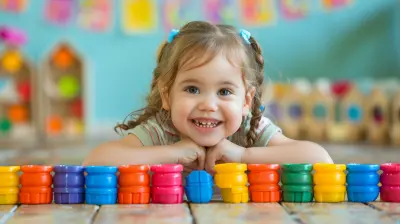20 June 2025
Social-emotional learning (SEL) is more than just a trend in education—it's a game-changer. In a world where kids are dealing with stress, anxiety, and the ever-growing pressure to succeed, helping them develop social and emotional skills is just as important as teaching them math or science. But how do you actually incorporate SEL into your lesson plans?
In this guide, we’ll break down exactly what SEL is, why it matters, and how to seamlessly integrate it into your daily lessons. Let's get started! 
What Is Social-Emotional Learning?
At its core, SEL is about teaching students how to manage their emotions, build positive relationships, and make responsible decisions. The Collaborative for Academic, Social, and Emotional Learning (CASEL) defines SEL around five core competencies:1. Self-Awareness – Understanding one’s own emotions, thoughts, and values.
2. Self-Management – Learning how to regulate emotions and handle stress.
3. Social Awareness – Being empathetic and understanding different perspectives.
4. Relationship Skills – Developing the ability to form healthy relationships and communicate effectively.
5. Responsible Decision-Making – Making ethical and constructive choices in personal and social situations.
These skills aren’t just useful in the classroom—they're life skills that set students up for success beyond school. 
Why Is SEL Important in Education?
Think back to your own school days. What lessons stuck with you the most? Chances are, it wasn’t just the algebra formulas or history dates—it was the moments when a teacher helped you navigate a problem, comforted you when you were upset, or taught you how to work through a disagreement with a friend.Social-emotional learning does more than just create "nice" students. Research shows that integrating SEL into lessons leads to:
- Improved academic performance
- Better classroom behavior
- Reduced emotional distress
- Stronger relationships with peers and teachers
In short, kids who are emotionally supported learn better, behave better, and grow into well-adjusted adults. So, how do we weave SEL into our lesson plans? 
Steps to Creating an SEL-Based Lesson Plan
1. Identify Your SEL Goals
Before diving in, ask yourself: What specific SEL skill do I want my students to develop? Whether it’s self-awareness, conflict resolution, or empathy, being clear on your goal will help shape your lesson.For example:
- Goal: Teach students how to express their emotions constructively.
- Lesson Focus: Using "I" statements instead of blaming language.
Having a clear objective makes lesson planning easier and more effective.
2. Choose Activities That Encourage SEL
Not every activity needs to be an emotional deep dive, but certain strategies naturally integrate SEL into your lessons. Here are a few easy ways to do it:Morning Check-Ins
Start the day by asking students how they’re feeling. A quick "How are you today?" chart or a one-word emotion check-in helps students practice self-awareness and recognize how emotions impact their day.Role-Playing Scenarios
Want to teach empathy and social awareness? Act out real-life situations! Have students role-play conflicts, such as resolving a disagreement with a friend or responding to peer pressure.Reflective Journals
Encourage students to write about their feelings. You can pose questions like:- What was the best part of your day?
- How did you handle a difficult situation today?
- What’s something you're proud of?
Writing fosters self-awareness and emotional processing.
Collaborative Group Work
Working in teams develops relationship skills. Give students group projects where they must communicate, compromise, and solve problems together.Mindfulness & Breathing Exercises
A two-minute deep breathing exercise can do wonders for student stress levels. Teaching mindfulness helps with self-regulation and focus.3. Incorporate SEL into Academic Subjects
SEL doesn’t have to be a separate lesson—it can be seamlessly woven into subjects like math, science, and language arts. Here’s how:Language Arts: Teach Perspective & Empathy
- Assign books with diverse characters and discuss emotions.- Have students write personal narratives reflecting on important experiences.
Math: Foster Problem-Solving Skills
- Encourage teamwork to solve word problems.- Teach frustration management when dealing with challenging math concepts.
Science: Develop Curiosity & Critical Thinking
- Discuss ethical issues in science, like climate change or medical research.- Explore emotional resilience by studying how scientists handle failure.
History: Promote Social Awareness
- Analyze historical conflicts and decision-making.- Discuss how leaders demonstrated emotional intelligence.
When SEL is woven into academics, it becomes a natural part of learning rather than an "extra" subject.
4. Model SEL Behaviors as a Teacher
Students learn by example. If you want your students to regulate their emotions, cooperate, and show empathy, you need to demonstrate those behaviors yourself.Here are ways you can model SEL daily:
- Verbalize your emotions: "I’m feeling a little frustrated right now, so I’m going to take a deep breath."
- Show empathy: "I see you’re upset. Want to talk about it?"
- Use positive reinforcement: Acknowledge when students demonstrate SEL skills: "I love how you worked through that disagreement respectfully!"
The more students see SEL in action, the more naturally they'll apply those skills in their own lives.
5. Assess SEL Growth
How do you measure something as abstract as "emotional growth"? Unlike a math test, SEL progress isn’t always easy to quantify, but here are a few ways to track it:- Self-Reflections: Have students answer prompts about their emotional growth over time.
- Teacher Observations: Take notes on how students interact, manage stress, or solve conflicts.
- Peer Feedback: Encourage students to give each other positive feedback on SEL skills.
Tracking progress ensures that SEL is making a real impact, helping students build lifelong skills. 
Overcoming Challenges in SEL Lesson Planning
Even though SEL is essential, integrating it into lesson plans can come with challenges. Here’s how to tackle common obstacles:Limited Time
Teachers are already juggling a packed curriculum. The solution? Infuse SEL into activities you’re already doing, rather than treating it as a separate subject.Student Resistance
Some students may struggle with opening up about emotions. Keep SEL activities low-pressure, use storytelling or role-playing, and allow students to engage at their own comfort level.Lack of Support
If school-wide SEL integration is lacking, start in your own classroom. Over time, as others see the benefits, more educators may get on board.Final Thoughts
Lesson planning for social-emotional learning isn’t about adding more to your plate—it’s about teaching students the essential skills they need to navigate life successfully.When kids learn how to manage emotions, communicate effectively, and make responsible choices, they thrive academically, socially, and emotionally. And as teachers, isn't that what we ultimately want for them?
By intentionally incorporating SEL into your lessons, you’re not just shaping better students—you’re shaping better humans.








Hugo McWhorter
Integrating social-emotional learning into lesson planning fosters resilience and empathy, essential skills for students' personal and academic success.
November 17, 2025 at 7:46 PM